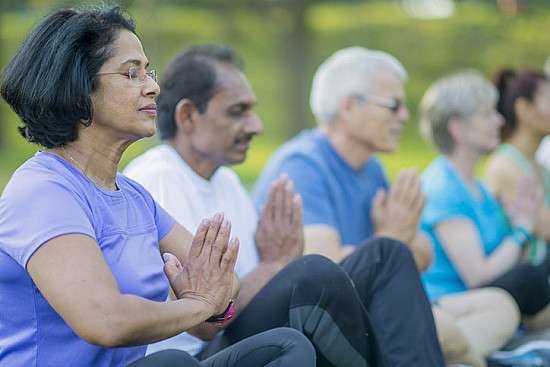Should you happen to have visited a major city in the past 10 or 20 years, you might have noticed a health trend: yoga. The thousands-year-old Indian spiritual practice made its way into gyms, universities and even religious centres worldwide. New yoga centres seem to pop up weekly, advertising new yoga styles and making new health claims. Interestingly enough, yoga is not just perceived as a recreational activity but mainly as a way to increase and maintain health: national surveys show that about 31 million U.S. adults (more than 13% of the population) have used yoga for health reasons.
Yoga has been shown in clinical trials to improve pain by stretching muscles and aligning posture, to lower blood pressure by rebalancing the autonomous nervous system and to reduce inflammation by regulating chronic stress. In recent times, yoga is more and more perceived not only as a way to reduce stress and increase physical fitness but also to overcome mental suffering. This should not really come as a surprise: already about 2000 years ago the Indian sage Patanjali, the “grandfather” of modern yoga, defined yoga as the “control of the fluctuations of the mind”. And “fluctuations of the mind”, rumination or uncontrollable thoughts are cardinal symptoms of several mental disorders.
This potential of yoga to control unwanted mind wandering has hit the big time when Hillary Clinton reported how “alternate nostril breathing”, a classical yogic breathing technique, helped her to heal from her election loss – and from giving up her lifelong dream of becoming president of the USA. However, beyond gossip and anecdotal evidence, there are hard scientific facts and clear mechanisms by which yoga might help with mental symptoms:
Trauma-related symptoms
Post-traumatic stress disorder (PTSD) is a major public health problem affecting up to 6% of the world population. PTSD results from substantial traumatic experiences and is thus far more common among veterans, survivors of wars or natural disasters, and victims of violence. The syndrome is characterized by re-experiencing, avoidance and arousal. PTSD is associated with a brain structure called the amygdala which connects the memory of certain experiences with emotions – in the case of PTSD the amygdala is overactivated and thereby constantly produces the aforementioned symptoms.
By reducing stress, yoga can increase parasympathic activity, this is the relaxation response, and could thereby directly reduce amygdala activity. This seems to be mainly driven by yogic breathing such as alternate nostril breathing. From a psychological viewpoint, PTSD is characterized by the paradox that patients feel anxious about the future although the traumatic event lies in the past. This is mainly driven by an overgeneralization of past experiences and negative appraisal of own actions, negative reactions by other people and life prospects.
Yoga involves aspects of mindfulness, this is a non-judgmental open attention to and acknowledgment of even unpleasant emotions or memories. This can increase emotion regulation rather than avoidance. The mindful awareness of the transitory nature of one’s momentary physical, sensory, and emotional experience during yoga practice is thought to lead to a change in self-appraisal, thereby reducing PTSD symptoms.
In line with these thoughts and theories, clinical trials have shown that yoga actually can reduce symptoms of PTSD: studies from North and South America and Australia have recruited veterans and other people with traumatic experiences and randomly allocated them to yoga interventions lasting weeks to months or to control groups which were not treated at all or received rather unspecific health counseling. In a meta-analysis of these studies, my colleagues and I demonstrate that those participants who practiced yoga experienced a much stronger and clinically relevant reduction in their symptoms – even if the yoga style was not specifically designed for participants with PTSD.
Fear and anxiety
Other studies have targeted anxiety disorders. Anxiety is a normal response to specific situations or events. Without anxiety, mankind would surely not have survived. However, excessive fear or anxiety may be indicative of an anxiety disorder. In generalized anxiety disorder (GAD) for example, elevated levels of anxiety, which are associated with concerns about health, relationships, work, and financial issues, lead to a wide variety of physical symptoms and behavioral changes. In the U.S., more than 4% of the population have been estimated to suffer from GAD alone.
Excessive anxiety also has implications for long-term health, with somatic symptoms of anxiety, such as palpitations and irregular heartbeat, being associated with an increased risk of cardiovascular disease. Interestingly, treating anxiety is one of the main reasons people give for practicing yoga. Again, mindfulness seems to play a key role here: patients with GAD have been shown to be less “mindful” than the general population, indicating that mindful body work, breathing and meditation can help here – perhaps by “controlling the fluctuations of the mind”? Interestingly, anxiety disorders are more prevalent among patients with breathing disorders such as asthma or chronic obstructive pulmonary disease and breathing retraining has been an essential part of many cognitive behavior therapy approaches for anxiety disorders.
Not surprisingly, yogic breathing is often seen as the main part of yoga when it comes to treating mental disorders, not the well-known yoga postures. The effects of yoga have been researched for a number of anxiety disorders, including GAD or phobia. We have analyzed these studies in a further meta-analysis. While the results are positive, most studies are quite old and do not fulfil the requirements of modern science, so replications are urgently needed. What yoga clearly does is relieving symptoms of anxiety in healthy individuals – be it diffuse everyday fear, examination anxiety or performance anxiety in musicians.
It remains unclear whether alternate nostril breathing alone can really ameliorate mental suffering. What is clear is that yoga can help with trauma-related symptoms and anxiety, and that breathing exercises are a main mechanism by which it does so. Needless to say that patients with mental disorders should not try yoga on their own but only after consulting their psychiatrist and psychotherapist. For minor everyday anxiety, simple yogic breathing techniques might be worth a try as a self-care strategy.
Yoga as an intervention in psychiatric disorders is not a recent concept, as doctors have been recommending yoga-based interventions for stress-related disorders since a long time. However, there has been a renaissance in the last two decades, in terms of a scientific approach and modern research methods to the study of yoga-based interventions.
Yoga practice is known to improve a person’s physical and mental functioning. In psychiatry, yoga-based interventions have been successfully used both as a standalone and a supportive treatment of disorders such as depression, anxiety, and insomnia. Yoga has also been beneficial as a complementary treatment for psychiatric conditions such as schizophrenia, Attention Deficit Hyperactivity Disorder (ADHD) in children, and cognitive impairment in the elderly.
Yoga practice has led to improved cognitive performance in persons with depression, better emotion recognition abilities in persons with schizophrenia, and improved memory, sleep and quality of life in elderly persons with mild memory impairment.
Regular practice of yoga causes a reduction in the ‘stress hormone’ cortisol, increase in the ‘cuddle hormone’ oxytocin and increase in markers of brain plasticity such as Brain Derived Neurotrophic Factor (BDNF). It helps prevent degeneration of brain cells, or even an increase of brain volume in areas related to memory (hippocampus), especially in the elderly A neuro-imaging study on healthy persons showed that chanting ‘Om’ reduced brain activation in areas related to emotional control, suggesting that it has the potential to calm emotional disturbances.
 Getty Images
Getty Images
Yoga does the body good, and according to a new study, it may ease the mind as well.
“Yoga has also become such a cultural phenomenon that it has become difficult for physicians and consumers to differentiate legitimate claims from hype,” researchers from Duke University Medical Center write in their study, published in the journal Frontiers in Psychiatry. In order to explore the widely held belief that practicing yoga can relieve mental stress, the team reviewed more than 100 studies on the effect of yoga and mental health.
“Most individuals already know that yoga produces some kind of a calming effect. Individually, people feel better after doing the physical exercise,” says lead study author Dr. P. Murali Doraiswamy, a professor of psychiatry and medicine at Duke University Medical Center. “Mentally, people feel calmer, sharper, maybe more content. We thought it’s time to see if we could pull all [the literature] together … to see if there’s enough evidence that the benefits individual people notice can be used to help people with mental illness.”
(MORE: Yoga Can Help Stroke Survivors Regain Their Balance)
Their findings suggest that yoga does in fact have positive effects on mild depression and sleep problems, and it improves the symptoms of psychiatric disorders like schizophrenia and ADHD among patients using medication.
The researchers focused on 16 studies that recorded the effects of practicing yoga on mental-health issues ranging from depression, schizophrenia, ADHD, sleep complaints and eating disorders to cognitive problems. They found positive effects of the mind-and-body practice for all conditions with the exception of eating disorders and cognition. Those studies involved too few participants or produced conflicting results to draw any meaningful conclusions.
Some of the studies included in the analysis even suggested that yoga might affect the body in ways similar to antidepressants and psychotherapy. For instance, yoga may influence brain chemicals known as neurotransmitters (boosting levels of feel-good agents like serotonin), lower inflammation, reduce oxidative stress and produce a healthier balance of lipids and growth factors — just as other forms of exercise do.
(MORE: We Tried This: Aerial Vinyasa (or Upside-Down) Yoga)
Embracing yoga as a complementary treatment for mental disorders is not uncommon. Yoga is a feature in many veterans’ centers throughout the country, backed by research funded by the Department of Veterans Affairs. The Huffington Post reported that many troops use yoga as a form of treatment for PTSD, for example, with companies like Warriors at Ease training instructors in yoga techniques specifically catered to those in the military. A study published earlier this month of 70 active-duty troops found daily yoga eased anxiety and improved sleep.
The researchers say there’s enough evidence to warrant a larger study on the effects of yoga on mental health, and it should be considered as part of treatment for more disorders. “Many millions of Americans are doing yoga and many millions of Americans have mental illnesses and are popping psychiatric pills daily. Despite all of this, the vast majority of studies looking at the benefits of yoga are all small studies. We did not come across a single study where there was a coordinated effort done by some large agency to really conduct a large national study,” says Doraiswamy.
(MORE: Does Yoga Really Drive People Wild with Desire?)
But while the research is promising, yoga likely won’t be a panacea for mental illness. Nor should patients try to replace their medications with the practice. “What we are saying is that we still need to do further, large-scale studies before we are ready to conclude that people with mental illnesses can turn to yoga as a first-line treatment,” says Doraiswamy. “We are not saying throw away your Prozac and turn to yoga. We’re saying it has the promise and potential. If a large national study were done, it could turn out that yoga is just as good and may be a low cost alternative to people with unmet needs.” In the meantime, he says it doesn’t hurt to add yoga to existing treatments so patients can take advantage of any potential benefits.




